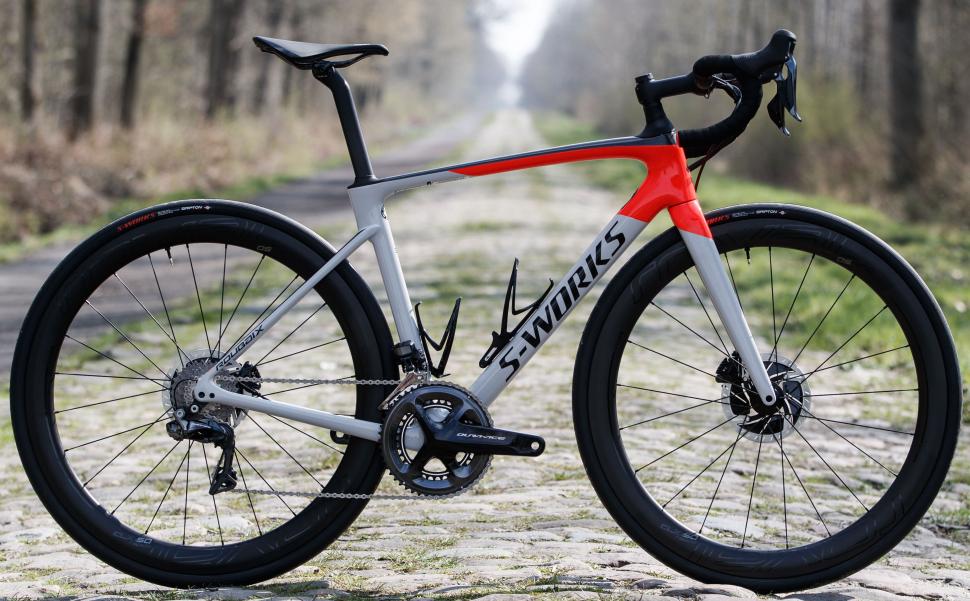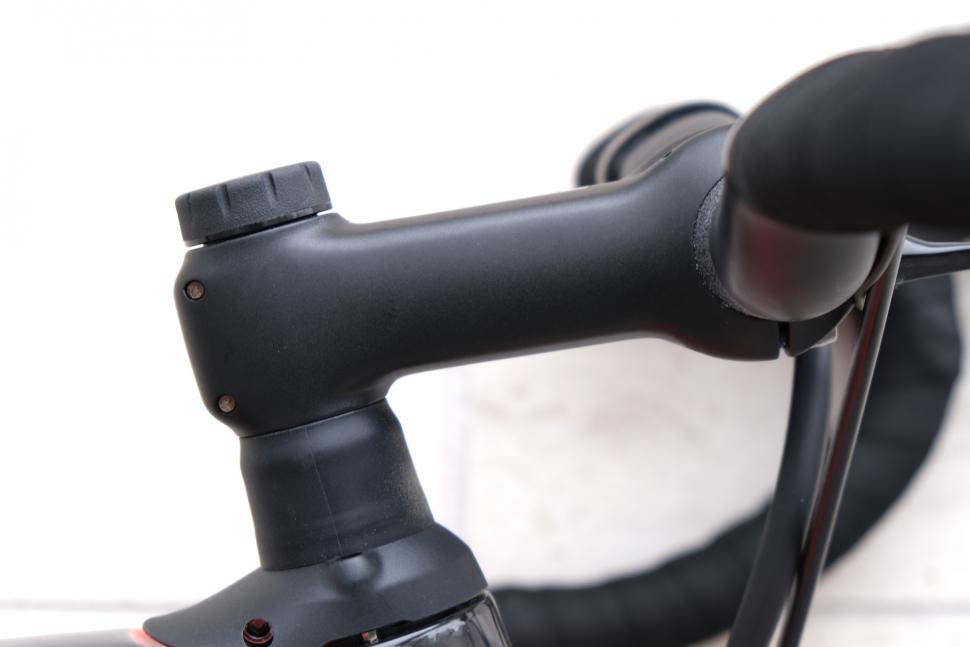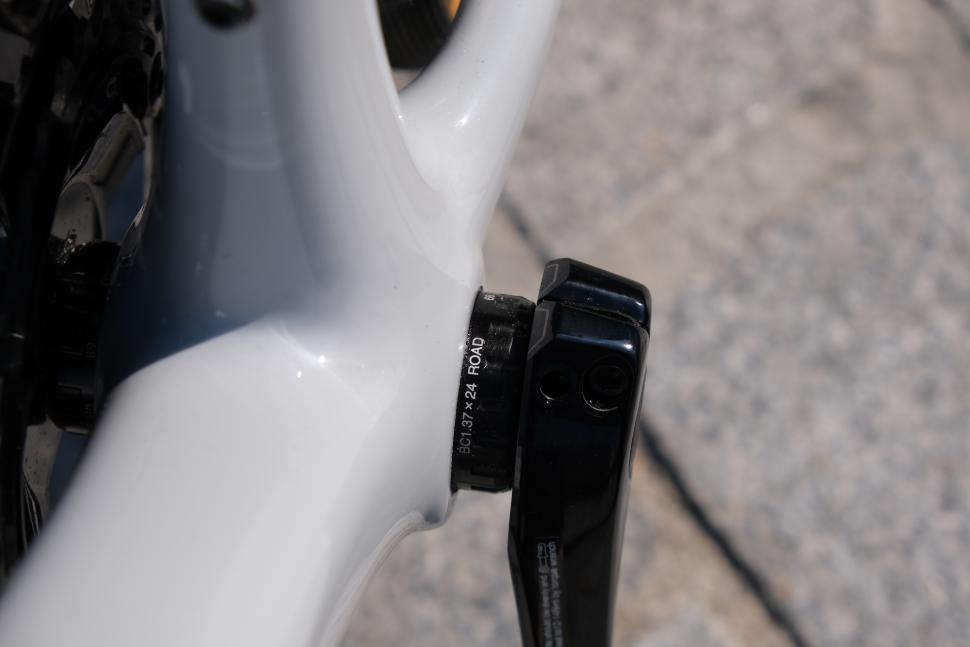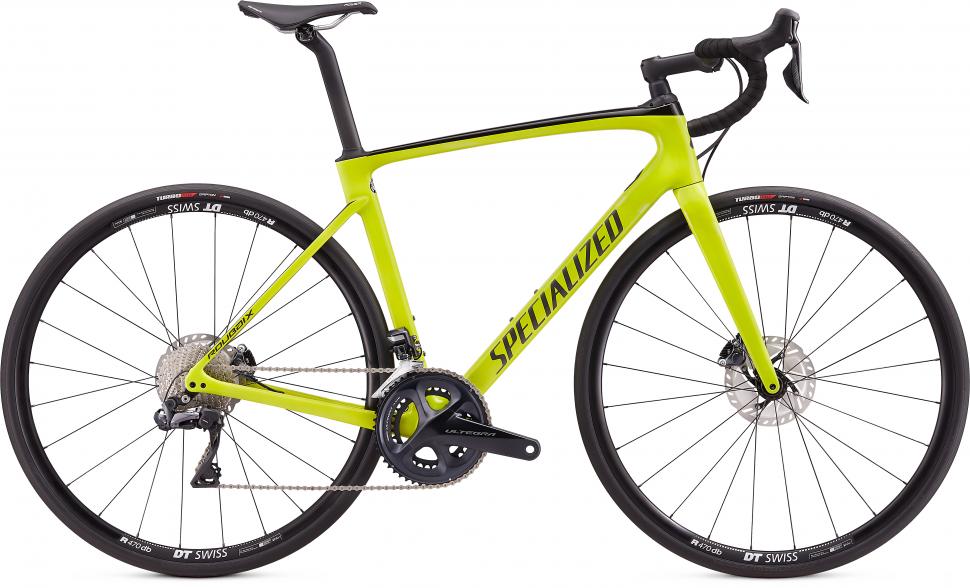- News
- Reviews
- Bikes
- Components
- Bar tape & grips
- Bottom brackets
- Brake & gear cables
- Brake & STI levers
- Brake pads & spares
- Brakes
- Cassettes & freewheels
- Chains
- Chainsets & chainrings
- Derailleurs - front
- Derailleurs - rear
- Forks
- Gear levers & shifters
- Groupsets
- Handlebars & extensions
- Headsets
- Hubs
- Inner tubes
- Pedals
- Quick releases & skewers
- Saddles
- Seatposts
- Stems
- Wheels
- Tyres
- Tubeless valves
- Accessories
- Accessories - misc
- Computer mounts
- Bags
- Bar ends
- Bike bags & cases
- Bottle cages
- Bottles
- Cameras
- Car racks
- Child seats
- Computers
- Glasses
- GPS units
- Helmets
- Lights - front
- Lights - rear
- Lights - sets
- Locks
- Mirrors
- Mudguards
- Racks
- Pumps & CO2 inflators
- Puncture kits
- Reflectives
- Smart watches
- Stands and racks
- Trailers
- Clothing
- Health, fitness and nutrition
- Tools and workshop
- Miscellaneous
- Buyers Guides
- Features
- Forum
- Recommends
- Podcast
TECH NEWS
 specialized roubaix pave
specialized roubaix paveSpecialized Roubaix 2020 First Look: Everything you need to know about the new endurance bike
A few days before the start of the legendary race it is named after, Specialized has unveiled a brand new Roubaix. The new bike builds on the 2016 redesign and is claimed to be more aerodynamic not only than the bike it replaces but also Specialized's current Tarmac SL6 race bike, whilst also having lighter, stiffer frame and incorporating the new on-the-fly adjustable Future Shock 2.0 with rebound and compression damping.
New Roubaix at a glance:
- Adjustable Future Shock 2.0 with rebound and compression damping
- 900g frame - Lighter than the Venge
- More aero than the Tarmac SL6
- 33mm tyre clearance
- Threaded bottom bracket on all models
- New Pave seatpost and internal seat clamp
- Same geometry but the addition of three pro race versions
- Priced from £2,600 to £10,000
First launched in 2004, the Roubaix has come a long way in 15 years. At its launch, it was a radical new approach to bike design, focused on comfort via both a frame engineered to provide compliance and more relaxed upright geometry for cyclists who don’t want the back strain.
It was a success, perhaps not overnight, but it has gone on to become a hugely popular model for the US company and helped to forge an entire new sportive/endurance category of bikes that are of great importance to many bike brands.
Set against that backdrop of sportive riding, the Roubaix, as its name suggests, was also designed for the most demanding and gruelling race on the pro cycling calendar. Featuring more than 50km of ferocious pave on a 280km route across northern France, Paris-Roubaix is the most visually iconic one-day bike race in the world. Like gladiators, the racers battle on the brutal cobbled roads and legends are crowned in the historic Roubaix velodrome and names immortalised in the concrete showers.
- Read the first ride review here.
So the Roubaix needs to be fast and capable on the cobbles at the hands of the pros, but comfortable and easy to ride for us mere mortals. It’s a tricky challenge, and it’s forced the Roubaix to constantly evolve into what has been launched today.
Future Shock 2.0
Smoother is faster is the mantra with the new bike. It’s a philosophy that goes right back 30 years to the company’s first foray into mountain bike suspension with the original and now iconic FSR. Smoother is faster is also evidenced with any wheeled vehicle, from your own motor car to an F1 racing car or motorbike.
Development for the original Future Shock began in 2012 and first featured on the radical 2016 Roubaix redesign model this new bike replaces. That 2016 bike was a ground-up redesign, with the long-running Zertz inserts consigned to the engineering department floor and replaced by the Future Shock, a sprung cartridge underneath the stem designed to help isolate the rider from bumps and vibrations.
In case you missed the previous Roubaix and are wondering what the Future Shock is, it’s a cartridge damper providing 20mm of vertical movement at the handlebar, positioned as it is below the stem and above the head tube. This is important because it's about suspending the rider, not the bike: only about 15% of a rider's body weight is on the handlebars - which is where their Future Shock suspension system comes in. As well as providing more comfort, it also promotes the benefits of increased traction with a claimed 5.8% improvement over a rigid front-end.
It hasn’t been without its problems, with the clamping steerer tube collars leading to a recall in early 2019. To be clear, the issue wasn't with the Future Shock itself but the clamping collar around the top of the stubby steerer tube which is used for preloading the headset bearings that appears to be the cause of the issue. But it’s a problem it duly fixed for all bikes produced since.
The new Future Shock 2.0 still provides 20mm of movement, but it has two major changes. First is the on-the-fly adjustment, allowing the rider to adjust between fully open and locked out. Previously Future Shock could be tuned for different roads and riders by swapping out the springs, but that adjustment has been simplified with a turn dial.
Twist it anticlockwise to open the shock for taming bumpy roads, twist it clockwise to firm it up. It’s not actually fully locked out in this position, but firm enough that it doesn’t move under your body weight when sprinting or climbing out of the saddle. Impacts of sufficient force will still activate it to a small degree.
“A lockout was requested by some riders for the Future Shock but in reality, the rider just wanted more control to lessen the erratic nature they experienced on some rides because of their style of riding,” explains Specialized.
I should add that wasn’t my experience when reviewing the Roubaix a few years ago, I was highly impressed with its ability to soak up bumps without introducing a vagueness to the ride feel and never felt the need or desire to lock it out, even on smoother roads (though there aren’t many of those around my parts).
An early development Future Shock 2.0 was first trialled by Peter Sagan when he won last year’s Paris-Roubaix. If you watch footage from that race you’ll see him twiddling his knob between pave sectors. It’s since been developed and refined and wrapped up in an all-new bike.
The other big change to the Future Shock 2.0 is the introduction of a hydraulic damper. A simple single circuit thru-shaft damper controls compression and rebound and should provide a lot more control than the undamped original. You can’t adjust the damping, but it should give the Future Shock a more refined feel with more control.
The Future Shock 2.0 has also been given an aesthetic makeover. There was plenty of commentary about the unique look of the original Future Shock’s rubber boot when the Roubaix first launched, so the design team tasked themselves the challenge of making it look more streamlined and, let’s be honest, less ugly. A smooth rubber boot along with a dedicated Future stem all help to provide a better-looking front-end. But what do you think? Let us know below in the comments.
Future Shock 1.5 for Comp and Sport models
Unfortunately, the new Future Shock 2.0 hasn’t been rolled out across the entire range. It’s available on the Expert, Pro and S-Works bikes, but the Comp and Sport instead utilise Future Shock 1.5, an update on the previous Future Shock developed for the current Roubaix.
It has a lighter and more progressive spring with new bottom-out and top-out bumpers to improve the control instead of the damper in the Future Shock 2.0. It’s a lighter spring than that used in the Diverge which helps to give the Future Shock 1.5 a smoother action. It’s also claimed to be quieter when unloaded too.
If you’re wondering if you can fit the new Future Shock 2.0 to your current Roubaix, I’m afraid it’s a no. The new cartridge has slightly different dimensions (it’s longer) that means it’s not backwards compatible.
As for servicing, it’s a totally sealed unit and you’re looking at 500 hours or 1.5-year service intervals, whichever comes first. There’s still the same 30mm of stack adjustment via different top spacers.
Don’t worry, you’re not tied into the Future stem, any stem from any brand can be fitted. If you use it, the Future stem is offered in lengths from 70 to 130mm with a 6-degree rise and offers an integrated computer mount. There's also the Hover handlebar, available in three rises to help cyclists achieve the perfect fit.
The new stem also provides an out-front Barfly computer mount compatible with Garmin and Wahoo computers.
New Pave seatpost
The other key design focus was ensuring a suitable balance from the front to the rear of the bike. The new Roubaix maintains the same 65mm lower seatpost clamp to allow the seatpost to deflect when the back wheel smashes into a cobble.
However, Specialized has tidied up the design, swapping from a two-bolt external clamping setup to an internal wedge design. This is aimed at allowing easier adjustment with the bolt hidden underneath a tight-fitting rubber seal. The rubber is designed to be flexible to allow the post to move back and forth.
Then there is the new Pave seatpost which replaces the long-running CGR post. It’s a smarter looking design - there weren’t many fans of the CGR post - but it maintains the same level of compliance. It’s also aerodynamic owing to the fact it’s the same profile as the Tarmac SL6 seatpost and is 80g lighter.
Specialized didn’t arrive at the new Pave without a few other design ideas. During the development of the new bike, Specialized even cobbled together a Future Shock into a seatpost but apparently found it produced strange sensations that didn’t align with its desire to maintain pedalling efficiency, along with being heavy and ugly.
Because of the profile, the Pave seatpost can be fitted to the Tarmac which might be an interesting option but could lead to an unbalanced ride feel, with a stiff front-end and soft back-end, so obviously Specialized doesn’t recommend this, though there’s nothing to stop you from trying.
All models, from the entry-level to the S-Works will be fitted with the same all-carbon Pave seatpost. It’ll also be available in a zero offset option.
More aero than the Tarmac SL6
The Roubaix becomes an aero endurance bike. Races are getting faster and aerodynamics has become a key pillar of bike design in recent years. In 2017 Greg Van Avermaet won the fastest ever edition of Paris-Roubaix, completing the 257km course in a staggering 45.204kph (thanks in part to a generous tail wind).
This along with feedback from the team that the Roubaix bike wasn’t as fast as the Venge or Tarmac prompted Specialized to consider the aerodynamic performance of its endurance model for the first time. By utilising the same computer modelling software and expertise gained in developing the recent Venge, the new Roubaix is more aerodyamic: a claimed 24 seconds faster over 40km compared to the current Roubaix.
Specialized adds that the bike is faster than the old Roubaix at any speeds, and cyclists travelling at lower speeds stand to gain even more simply because they are on the road for longer than speedier cyclists.
Even more impressive is the fact that the Roubaix is faster than the current Tarmac SL6 at all measured yaw angles! That an endurance bike is more aero than a regular ride bike is astounding, and certainly opens the door to aero becoming a factor of all future endurance bikes built for racing as much as for sportive riders.
The improved aerodynamics is achieved via new profiles for the head tube, fork blades, downtube, seat tube and seatpost, and the enlarged seat clamp area.
Lighter than old Roubaix
You’d expect the new bike to be lighter, and you’d be right. Specialized has produced a claimed sub-900g frame for the S-Works version. But instead of just focusing on the frame, the system weight (frame, fork, Future Shock 2.0, headset and seatpost) are 50g lighter on the S-Works and 175g on the entry-level models.
The top of the range S-Works models are made from the highest grade FACT 11r carbon fibre, while the Base, Sport, Comp, Expert and Pro models use a FACT 10r carbon fibre frame.
Details details details
Specialized really focused on the details and one of the biggest changes that will get a round of applause is the decision to use a threaded bottom bracket on all models, from the cheapest to the most expensive S-Works bikes. Press-fit really is facing some serious challenges to its once dominant place on high-end road bikes, but will anybody miss it if it vanishes completely? Probably not is my bet.
Tyre clearance is wider than the previous model with the max width pegged at 33mm, with all bikes specced with 28mm tyres. The max width does depend on the tyre and rim combination but it’s a small improvement on the previous bike which was extremely tight on a 32mm tyre.
That the new Roubaix doesn’t have even wider tyre clearance is due to Specialized feeling this is the as wide as an endurance bike wants to go without unduly compromising other aspects of its performance, and it has the Diverge if you truly want really wide tyre clearance. Still, some might consider it a missed opportunity not to go to 35mm or thereabouts for those riders wanting to increase the range of terrain the bike is capable of tackling.
Geometry
Rider-First Engineering is a key part of the redesign and as it has already done with other models in its range, Specialized has scrapped the women-specific bikes choosing instead gender neutral bikes. This is born out of analysing the vast database of digital fit data acquired by Retul (it bought the fit company a few years ago) which helped it to put aside traditional assumptions about gender differences.
By overlaying the range of bike sizes of this fit data it was able to revise the geometry, therefore removing the need for gender-specific bikes. Interestingly, Specialized found that there’s more likely to be differences between two men than between a male and female. Specialized says this is about bringing performance to everyone, no matter the gender, height or any other differences.
The new Roubaix then is available in 11 frame sizes but three of those sizes are the new S-Works Team Geo, distinguished by using the same geometry but with a shorter head tube length and reach. These frames were developed for the pros to be able to mirror their Tarmac/Venge fits, and Specialized is now offering these frames to customers for the first time.
The three sizes, 53, 57 and 59cm have the same size as the Tarmac in sizes 54, 56 and 58cm respectively.
I want one, how much will it cost?
If you want a Roubaix with the new Future Shock 2.0, you have to look at the Expert, Pro and S-Works models, the Comp and Sport use the Future Shock 1.5.
The Roubaix Sport at £2,600 kicks off the range and is specced with a Shimano 105 groupset with Praxis chainset and hydraulic disc brakes. The £3,400 Roubaix Comp with Shimano Ultegra mechanical is probably the pick of the range from a performance/affordability basis with aluminium DT Swiss wheels and an Adventure Gear Hover handlebar.
The bike I’ve been riding is the S-Works Dura-Ace Di2 bike costing £9,500 with Roval CLX50 wheels, S-Works Power saddle and S-Works Carbon Hover Drop handlebar (pictured above).
- ROUBAIX SW DI2 SAGAN COLLECTION £10,000.00
- ROUBAIX SW RED ETAP (with power) £9,500.00
- ROUBAIX SW DI2 (no power) £9,000.00
- ROUBAIX PRO FORCE ETAP £6,400.00
- ROUBAIX EXPERT UDI2 £5,400.00
- ROUBAIX COMP UDI2 £4,400.00
- ROUBAIX COMP £3,400.00
- ROUBAIX COMP SAGAN COLLECTION £3,400.00
- ROUBAIX SPORT £2,600.00
- ROUBAIX SW FRMSET SAGAN COLLECTION £3,500.00
- ROUBAIX SW FRMSET £3,400.00
When can I buy one?
Right now! Specialized has lined up the unveiling of the new bike with availability in bike shops so your local dealer should have a shiny new Roubaix sitting on the showroom floor if you pop in there this weekend.
You can get more info at www.specialized.com
What's it like to ride?
I've been out in Belgium and France riding the new Roubaix over the cobbled roads it was designed for, and which it will be raced over this weekend. First impressions only tell you so much - we'll get a more in-depth review once we've been riding the new bike on our own roads in the UK - but it's clear the new bike is incredibly smooth on the cobbles with more comfort and more control.
It’s clear now as when I first tested the original Roubaix that the Future Shock is no gimmick. If you want a smoother ride on pave, the Future Shock delivers. Combined with the new Pave seatpost and 28mm wide tubeless sets inflated to 4.8 bar, the bike does an excellent job of providing a smooth ride. It's less jarring with more of the vibrations and impacts softened, and not only does this help isolate you from the savagery of blasting along cobbles and lead to less fatigue and general discomfort, but it also results in improved control and confidence.
Here's a more in-depth first ride. Once we get our hands on a bike back home we'll work on bringing you a full review. In the meantime, if you have any questions do feel free to ask them below.
David worked on the road.cc tech team from 2012-2020. Previously he was editor of Bikemagic.com and before that staff writer at RCUK. He's a seasoned cyclist of all disciplines, from road to mountain biking, touring to cyclo-cross, he only wishes he had time to ride them all. He's mildly competitive, though he'll never admit it, and is a frequent road racer but is too lazy to do really well. He currently resides in the Cotswolds, and you can now find him over on his own YouTube channel David Arthur - Just Ride Bikes.
Latest Comments
- hawkinspeter 2 hours 52 min ago
The obvious answer to that question is whether you support genocide or not. It's similar to claiming that Nazis shouldn't be punched because that...
- chrisonabike 3 hours 52 min ago
The issue is we just end up with wider vehicles parked on the road because they won't fit the garage *, and it being more likely that drivers will...
- Pub bike 4 hours 20 min ago
He is up against the global trading system, which has obviously been in the news a lot lately. Framebuilders in other countries can undercut him,...
- David9694 5 hours 53 min ago
Stouport residents bemoan huge traffic queues through town...
- rookybiker 16 hours 47 min ago
The trailer seems to connect to both ends of the rear axle. Can it do tight corners without dragging the tyre sideways?
- froze 16 hours 50 min ago
Motorists have always been unkind to cyclists, but distracted driving is adding to the problem....
- Destroyer666 17 hours 43 min ago
Have you owned Bont shoes? In my experience even the widest Lake shoes have had a bizarre form of narrowing way too much in the toe area. But the...
- froze 18 hours 11 min ago
Not sure if this is possible, but this news letter goes out all over the world, and some places like Decathlon does not send stuff to America, in...
- Hirsute 18 hours 56 min ago
I'm confused as to why you'd need bib shorts indoors.






















Add new comment
34 comments
Yep. Watched the race last year and can’t say I noticed, thankfully. Must have been discreet.
And he still won! What a champ.
Bit excited about Sunday, watched Hell of the North last weekend, I'm asking if there are any easy methods for watching the race, nothing iffy and I'm not keen on signing up to introductory offers, though as the excitement builds....?
I don't know if geographical area makes a difference, but steephilltv.com carries a lot of races, and you don't need to sign up to anything.
Pages